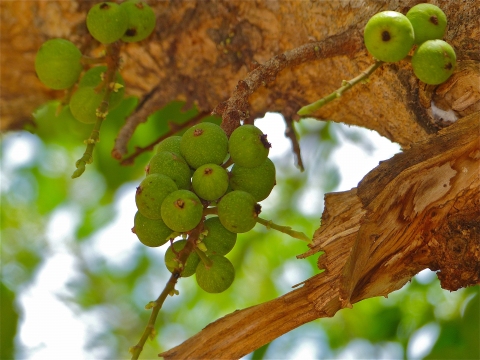Ficus sansibarica
Warb.
Moraceae
Ficus delagoensis Sim.
Ficus langenburgii Warb.
Common Name:
General Information
Ficus sansibarica is a tree usually growing up to 20 metres tall but exceptionally to 40 metres. The plant often begins life as an epiphyte, growing in the branch of another tree; as it grows older it sends down aerial roots which, when they reach the ground quickly form roots and become much thicker and more vigorous. They supply nutrients to the fig, allowing it to grow faster than the host tree. The aerial roots gradually encircle the host tree, preventing its main trunk from expanding, whilst at the same time the foliage smothers the foliage of the host. Eventually the host dies, leaving the fig to carry on growing without competition[
308- Title
- Flora Zambesiaca
- Publication
-
- Author
-
- Website
- http://apps.kew.org/efloras/fz/intro.html
- Publisher
-
- Year
- 0
- ISBN
-
- Description
- An excellent online flora of plants from the Zambezi River basin. It lists a number of the plant uses as well as the habitats and botanical descriptions of the plants.
].
The tree is harvested from the wild for local use as a food, medicine and material for basket making. It is planted in villages for amenity and to provide shade[
].
Known Hazards
None known
Botanical References
308- Title
- Flora Zambesiaca
- Publication
-
- Author
-
- Website
- http://apps.kew.org/efloras/fz/intro.html
- Publisher
-
- Year
- 0
- ISBN
-
- Description
- An excellent online flora of plants from the Zambezi River basin. It lists a number of the plant uses as well as the habitats and botanical descriptions of the plants.
Range
Tropical Africa - Senegal to DR Congo, Uganda and Kenya, south to Angola, Zambia, Zimbabwe, Botswana, Mozambique, Swaziland and S. Africa.
Habitat
Riverine and evergreen forests, miombo and coastal woodland, usually at low elevations[
308- Title
- Flora Zambesiaca
- Publication
-
- Author
-
- Website
- http://apps.kew.org/efloras/fz/intro.html
- Publisher
-
- Year
- 0
- ISBN
-
- Description
- An excellent online flora of plants from the Zambezi River basin. It lists a number of the plant uses as well as the habitats and botanical descriptions of the plants.
].
Properties
| Edibility Rating |      |
| Medicinal Rating |      |
| Other Uses Rating |      |
| Habit | Tree |
| Height | 15.00 m |
| Pollinators | Wasps |
| Cultivation Status | Cultivated, Wild |
Cultivation Details
Fig trees have a unique form of fertilization, each species relying on a single, highly specialized species of wasp that is itself totaly dependant upon that fig species in order to breed. The trees produce three types of flower; male, a long-styled female and a short-styled female flower, often called the gall flower. All three types of flower are contained within the structure we usually think of as the fruit.
The female fig wasp enters a fig and lays its eggs on the short styled female flowers while pollinating the long styled female flowers. Wingless male fig wasps emerge first, inseminate the emerging females and then bore exit tunnels out of the fig for the winged females. Females emerge, collect pollen from the male flowers and fly off in search of figs whose female flowers are receptive. In order to support a population of its pollinator, individuals of a Ficus spp. must flower asynchronously. A population must exceed a critical minimum size to ensure that at any time of the year at least some plants have overlap of emmission and reception of fig wasps. Without this temporal overlap the short-lived pollinator wasps will go locally extinct[
413- Title
- Global Invasive Species Database
- Publication
-
- Author
-
- Website
- http://www.issg.org/database/welcome/
- Publisher
-
- Year
- 0
- ISBN
-
- Description
- Very detailed information on almost 400 species (with more being added) of plants that have become weeds in areas outside their native range.
].
Edible Uses
Fruit - raw[
,
398- Title
- Edible Wild Plants of Tanzania
- Publication
-
- Author
- Ruffo, C.K.: Birnie, A. & Tengnas, B.
- Publisher
- Regional Land Management Unit; Nairobi.
- Year
- 2002
- ISBN
- 9966-896-60-0
- Description
- A very well presented, simple guide to growing and utilizing wild food plants in Tanzania, with line drawings of each plant, a description, habitat and range, non-food as well as food uses, plus basic information on growing the plants.
]. The subglobose fruits can be up to 10cm in diameter[
308- Title
- Flora Zambesiaca
- Publication
-
- Author
-
- Website
- http://apps.kew.org/efloras/fz/intro.html
- Publisher
-
- Year
- 0
- ISBN
-
- Description
- An excellent online flora of plants from the Zambezi River basin. It lists a number of the plant uses as well as the habitats and botanical descriptions of the plants.
].
Medicinal
The figs are sometimes eaten by women as a tonic to promote fertility[
].
Other Uses
The split stems are used for making baskets[
].
Propagation
Seed -
If you have any useful information about this plant, please leave a comment. Comments have to be approved before they are shown here.





 Useful Tropical Plants Database 2014 by
Ken Fern,
web interface by
Ajna Fern
with help from
Richard Morris.
Useful Tropical Plants Database 2014 by
Ken Fern,
web interface by
Ajna Fern
with help from
Richard Morris.